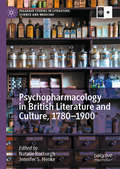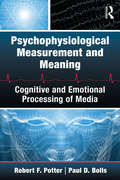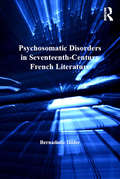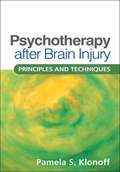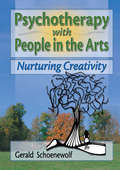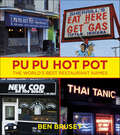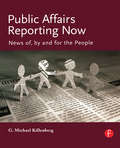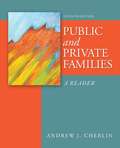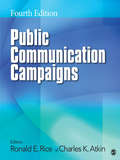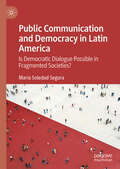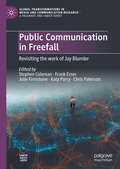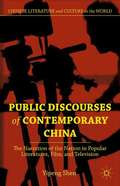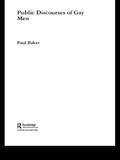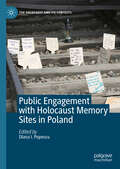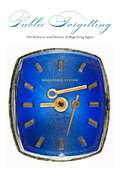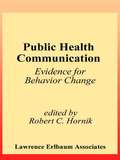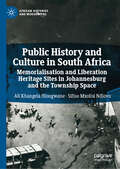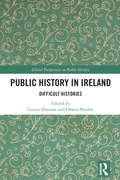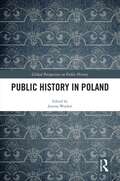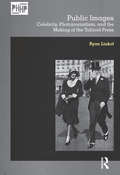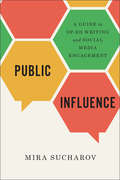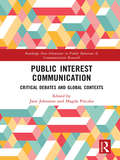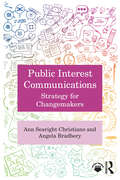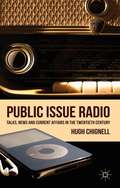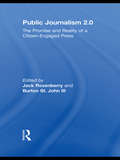- Table View
- List View
Psychopharmacology in British Literature and Culture, 1780–1900 (Palgrave Studies in Literature, Science and Medicine)
by Natalie Roxburgh Jennifer S. HenkeThis collection of essays examines the way psychoactive substances are described and discussed within late eighteenth- and nineteenth-century British literary and cultural texts. Covering several genres, such as novels, poetry, autobiography and non-fiction, individual essays provide insights on eighteenth- and nineteenth-century understandings of drug effects of opium, alcohol and many other plant-based substances. Contributors consider both contemporary and recent medical knowledge in order to contextualise and illuminate understandings of how drugs were utilised as stimulants, as relaxants, for pleasure, as pain relievers and for other purposes. Chapters also examine the novelty of experimentations of drugs in conversation with the way literary texts incorporate them, highlighting the importance of literary and cultural texts for addressing ethical questions.
Psychophysiological Measurement and Meaning: Cognitive and Emotional Processing of Media (Routledge Communication Series)
by Robert F. Potter Paul BollsThis research volume serves as a comprehensive resource for psychophysiological research on media responses. It addresses the theoretical underpinnings, methodological techniques, and most recent research in this area. It goes beyond current volumes by placing the research techniques within a context of communication processes and effects as a field, and demonstrating how the real-time measurement of physiological responses enhances and complements more traditional measures of psychological effects from media. This volume introduces readers to the theoretical assumptions of psychophysiology as well as the operational details of collecting psychophysiological data. In addition to discussing specific measures, it includes brief reviews of recent experiments that have used psychophysiological measures to study how the brain processes media. It will serve as a valuable reference for media researchers utilizing these methodologies, or for other researchers needing to understand the theories, history, and methods of psychophysiological research.
Psychosomatic Disorders in Seventeenth-Century French Literature
by Bernadette HöferBernadette Höfer's innovative and ambitious monograph argues that the epistemology of the Cartesian mind/body dualism, and its insistence on the primacy of analytic thought over bodily function, has surprisingly little purchase in texts by prominent classical writers. In this study Höfer explores how Surin, Molière, Lafayette, and Racine represent interconnections of body and mind that influence behaviour, both voluntary and involuntary, and that thus disprove the classical notion of the mind as distinct from and superior to the body. The author's interdisciplinary perspective utilizes early modern medical and philosophical treatises, as well as contemporary medical compilations in the disciplines of psychosomatic medicine, neurobiology, and psychoanalysis, to demonstrate that these seventeenth-century French writers established a view of human existence that fully anticipates current thought regarding psychosomatic illness.
Psychotherapy after Brain Injury
by Pamela KlonoffThis book presents hands-on tools for addressing the multiple ways that brain injury can affect psychological functioning and well-being. The author is a leader in the field who translates her extensive clinical experience into clear-cut yet flexible guidelines that therapists can adapt for different challenges and settings. With a focus on facilitating awareness, coping, competence, adjustment, and community reintegration, the book features helpful case examples and reproducible handouts and forms. It shows how to weave together individual psychotherapy, cognitive retraining, group and family work, psychoeducation, and life skills training, and how to build and maintain a collaborative therapeutic relationship.
Psychotherapy with People in the Arts: Nurturing Creativity
by Terry S Trepper Gerald SchoenewolfLearn to free creativity from the shackles of emotional conflicts!This riveting collection of case histories illustrates the dark interplay of neurosis and creativity. Psychotherapy with People in the Arts explores the struggles of writers, painters, actors, and composers to reconcile their overwhelming need to create and the self-doubts, frustrations, and neuroses that block their potential. In addition to ten inspiring tales of healing and self-knowledge, Psychotherapy with People in the Arts provides a solid introduction to the primary issues related to emotional disorders and creativity. It begins with a study of the notoriously reclusive and eccentric writer J. D. Salinger. Using both theory and case example, it shows how family history, present relations, and genetics can combine to impede the flow of an artist&’s natural gifts-and how a good therapist can help unblock that creative power. It also includes a series of tests to diagnose blocked creativity. Psychotherapy with People in the Arts explores such compelling themes as: dealing with racism and internalized self-hatred the conflict between commercial and high art anger and blocked tears the drive for an impossible perfection emotional alienation and sexual acting outPsychotherapy with People in the Arts is a fascinating look at a complex and controversial subject. Though not everyone is a professional artist, every human being has creative potential that can be blocked by emotional disturbances. And every therapist, mental health educator, and artist will find rich sources of information and inspiration in this book. Visit the author's website at http://www.livingcenter.net
Pu Pu Hot Pot: The World's Best Restaurant Names
by Ben Brusey100 snapshots of the world's most amazing, dreadful and utterly bizarre restaurant names"What's in a name?" -William Shakespeare (foodie)For too long, restaurants have been judged on the quality of their food. In some parts of the world, chefs have been known to waste literally hours of their lives carefully preparing and cooking stuff, only for other people to eat it and, later, part ways with it. This insanity must stop. There is only one thing to look for in a restaurant; a secret hidden in the pages of this laugh-out loud hilarious book. Ben Brusey has scoured the globe from Sunderland to Majorca to find the world's best-named restaurants, bars, and cafes. Breathtaking discoveries have been made, new standards of culinary excellence have been set. So, cancel that table at Per Se, forget that drink at the John Dory Oyster Bar, and open wide for a mouthful of wisdom guaranteed to leave you hungry, thirsty, and gagging for more. Why not savour the culinary delights of:- A SALT & BATTERY (New York, USA). Chef's tip: Don't make eye contact with him.- NEW COD ON THE BLOCK (Sheffield, UK). Previously THE GILL NEXT DOOR.- PHO SHIZZLE (Cambridge, Canada). Vietnamese has never been so gangsta.- THAI TANIC (Washington DC, USA). Our tip: Avoid the Iceberg Lettuce.- HINDENBURGER (Toronto, Canada). Flame grilled and disastrously good.- PU PU HOT POT (Boston, USA). The critics say: Chinese food guaranteed to put fire in your belly.- JESUS FAMILY RESTAURANT (Fort Worth, Texas). The Lord grills in mysterious ways.
Public Affairs Reporting Now: News of, by and for the People
by George Michael KillenbergEveryday life, no whether the issues or events arise next-door or a continent away, raises questions and concerns that the public counts on journalists to answer and, more important, confront. More than ever before, we all rely on the news media for warnings, explanations and insights. The profession - and society - cannot afford lazy, inept, uncommitted journalists. Today's reporters must learn how to cover public affairs intelligently and thoroughly. First you must learn about the institutions and people who influence the news; understanding how a legislative conference committee functions or how a trial is conducted remain important pre-requisites. But it is not enough merely to know how to report. Journalists must also understand how they see, define and influence the news.Don't be fooled by the daily dose of fluffy stories about fads, fashions or fetishes. People love to revel in celebrity gossip or fantasize about extreme makeovers. But Donald Trump's love life or the South Beach Diet don't satisfy when people worry about a home invasion in their neighborhood or a rezoning proposal to bring a Wal-Mart super center to town or a Department of Education report that their child's school scored bottom-most in reading achievement.Public Affairs Reporting Now is intended to teach you the best practices and give you the best advice for covering what's generically known as "public affairs reporting.? It's a term that's neither inspiring nor precise, but it's long been a convenient way of describing the kind of news coverage that keeps people informed as citizens and keeps our institutions, public and private, focused on the public good.
Public And Private Families: A Reader
by Andrew J. CherlinPublic and Private Families: A Reader, seventh edition, exemplifies Andrew Cherlin's belief that families matter in both the public and private sphere, and the book's 28 readings reflect this notion. Keyed to the fourteen chapters of Cherlin's successful text Public and Private Families: An Introduction, also in its seventh edition, the reader includes both veteran and updated materials that both supplement and enhance the introduction.
Public Communication Campaigns
by Ronald E. Rice Charles K. AtkinIn this fully revised and expanded Fourth Edition, Ronald E. Rice and Charles K. Atkin provide readers with a comprehensive, up-to-date look into the field of public communication campaigns. Updated to reflect the latest theories and research, this text extends coverage to new areas, including sun protection, organ donation, human rights, social norms, corporate social responsibility, condom use, ocean sustainability, fear messages, and digital games. Classic chapters include updates on topics such as campaign history, theoretical foundations, formative evaluation, systems approaches, input-output persuasion matrix, design and evaluation, meta-analysis, and sense-making methodology.
Public Communication and Democracy in Latin America : Is Democratic Dialogue Possible in Fragmented Societies?
by María Soledad SeguraThe book examines alternatives proposed and implemented by governments, civil society organizations, social movements and companies in Latin America to democratize public communication and overcome its current problems, such as the dissemination of alternative facts and fake news, anti-scientific discourse, harassing, discriminatory and hate speech, anti-human rights and anti-democracy discourses, and the contempt for political correctness. Drawing on theoretical approaches from media and communication, political studies and sociology, the book identifies strengths and weaknesses of the strategies for promoting democratic dialogue in Latin America and globally.
Public Communication in Freefall: Revisiting the work of Jay Blumler (Global Transformations in Media and Communication Research - A Palgrave and IAMCR Series)
by Stephen Coleman Frank Esser Katy Parry Julie Firmstone Chris PatersonThis book addresses key challenges facing global political communication at a time in which transformations in political practice, media ecology and cultural expectations both threaten traditional democratic norms and point to potential new ways of enacting political democracy. Drawing upon the outstanding theoretical insights of Jay Blumler to our understanding of the norms and practices of political communication, but also critically interrogating and updating them where appropriate, the volume asks timely questions about what publicness and democracy mean in the 2020s. Many people are talking and writing about the crisis of political democracy, fewer are talking about the role of the media in relation to that crisis. While many scholars have responded in an ad hoc way to the various crises of populism, polarisation, mis and disinformation, this book shows how Jay Blumler’s scholarship provides us with the tools and framework to research and understand the changing communication environment systemically and rigorously. The book demonstrates the applicability and relevance of Blumler’s work in explicating the current crisis of communication and the need for fresh and radical thinking in tackling it. The book's breadth and depth of chapters from a broad range of scholars from the East and West, ranging from long-standing contributors to the field to those in the early stages of their career, combine to produce a thoughtful and provocative invitation to reflect upon the concept of a ‘crisis of public communication’. We expect this book to become a major source for political communication students and scholars.
Public Discourses of Contemporary China
by Yipeng ShenExploring contemporary Chinese literature, film, and television, Yipeng Shen sheds light on the historical significance of nationalism for mass imagination and identification in the less-than-democratic system of China for the past three decades. Analyzing cultural products from a wide range of media, chapters move from the intellectual idealism of the 1980s, through the post-Tiananmen transition, to the national cinema of the 1990s, and finally to the Internet literature of today. Public Discourses of Contemporary China argues that Chinese subjects have, to varying degrees, transformed the state project of modernization into their own through mass aestheticization of the nation.
Public Discourses of Gay Men (Routledge Advances in Corpus Linguistics #Vol. 8)
by Paul BakerQueer linguistics has only recently developed as an area of study; however academic interest in this field is rapidly increasing. Despite its growing appeal, many books on ‘gay language’ focus on private conversation and small communities. As such, Public Discourses of Gay Men represents an important corrective, by investigating a variety of sources in the public domain. A broad range of material, including tabloid newspaper articles, political debates on homosexual law and erotic narratives are used in order to analyse the language surrounding homosexuality. Bringing together queer linguistics and corpus linguistics the text investigate how gay male identities are constructed in the public domain.
Public Engagement with Holocaust Memory Sites in Poland (The Holocaust and its Contexts)
by Diana I. PopescuThis book aims to address a neglected field of research by providing evidence-based insights into how contemporary visitors of different national and generational background, especially those of Polish and Jewish descent, experience and reflect on their visits, or on living in the proximity of different sites of memory across Poland, including former concentration and death camps, ghetto sites, and other physical sites such as museums with a connection to the Holocaust.
Public Forgetting: The Rhetoric and Politics of Beginning Again (G - Reference, Information and Interdisciplinary Subjects)
by Bradford VivianForgetting is usually juxtaposed with memory as its opposite in a negative way: it is seen as the loss of the ability to remember, or, ironically, as the inevitable process of distortion or dissolution that accompanies attempts to commemorate the past. The civic emphasis on the crucial importance of preserving lessons from the past to prevent us from repeating mistakes that led to violence and injustice, invoked most poignantly in the call of “Never again” from Holocaust survivors, tends to promote a view of forgetting as verging on sin or irresponsibility. In this book, Bradford Vivian hopes to put a much more positive spin on forgetting by elucidating its constitutive role in the formation and transformation of public memory. Using examples ranging from classical rhetoric to contemporary crises like 9/11, Public Forgetting demonstrates how, contrary to conventional wisdom, communities may adopt idioms of forgetting in order to create new and beneficial standards of public judgment concerning the lessons and responsibilities of their shared past.
Public Health Communication: Evidence for Behavior Change (Routledge Communication Series)
by Robert C. HornikThis volume argues the case that public health communication has affected health behavior. It brings together 16 studies of large-scale communication in a variety of substantive health areas--tobacco, drugs, AIDS, family planning, heart disease, childhood disease, highway safety--prepared by the authors who did the original research. These studies show important effects and illustrate the central conditions for success. The book also includes complementary analytic chapters which provide a meta-analysis of published results, some approaches to developing communication interventions, and alternative methods for evaluation of public health communication projects. Including studies based on communication programs in the United States, as well as projects done elsewhere in the world, including Europe, Africa, Asia and Latin America, this book: *offers a broad presentation of the alternative research designs that have been used to evaluate public health communication programs; *includes a great range of approaches from field experiments and natural experiments to simple before-after and complex time series designs, using data gathered from individuals and from archives; and *utilizes an innovative perspective on how to exercise public health communication from a leading and thoughtful practitioner. As such, it is required reading for scholars, students, practitioners, and policymakers in public health, health communication, health psychology, and related areas.
Public History and Culture in South Africa: Memorialisation and Liberation Heritage Sites in Johannesburg and the Township Space (African Histories and Modernities)
by Sifiso Mxolisi Ndlovu Ali Khangela HlongwaneThe post-apartheid era in South Africa has, in the space of nearly two decades, experienced a massive memory boom, manifest in a plethora of new memorials and museums and in the renaming of streets, buildings, cities and more across the country. This memorialisation is intricately linked to questions of power, liberation and public history in the making and remaking of the South African nation. Ali Khangela Hlongwane and Sifiso Mxolisi Ndlovu analyse an array of these liberation heritage sites, including the Hector Pieterson Memorial and Museum, the June 16, 1976 Interpretation Centre, the Apartheid Museum and the Mandela House Museum, foregrounding the work of migrant workers, architects, visual artists and activists in the practice of memorialisation. As they argue, memorialisation has been integral to the process of state and nation formation from the pre-colonial era through the present day.
Public History in Ireland: Difficult Histories (Global Perspectives on Public History)
by Leonie Hannan Olwen PurdueThrough a collection of essays that reflect the complexity of the island’s historical past as it operates today, Public History in Ireland delivers a scholarly yet accessible introduction to contemporary topics and debates in Irish public history.Despite the reputation that Ireland, both north and south, has gained as a place of contestation, this is the first book-length study to tackle its diverse and often ‘difficult’ public histories. Public History in Ireland offers examples drawn not only from museums, heritage and collections, prime mediators of public historical interpretation, but also from the work of artists and academics. It considers the silences in Ireland’s history-telling, including those of the recent conflict in Northern Ireland and of the traumatic public discoveries and re-evaluations of the island’s institutions of social control. The book’s key message is that history is active, making itself felt in ongoing debates about heritage, identity, nationhood, post-conflict society and reparative justice. It shows that Irish public history is freighted and often fraught with jeopardy, but as such it is rich with insight that has relevance far beyond this island’s shores.This book is useful for students, scholars and practitioners working in the fields of public history and the history of Ireland.
Public History in Poland (Global Perspectives on Public History)
by Joanna WojdonThis volume presents various aspects of public history practices in Poland, alongside their historical development and theoretical reflections on public history. Despite a long tradition and variety of forms of public history, the very term "public history", or literally speaking "history in the public sphere", has been in use in Poland only since the 2010s. This edited collection contains chapters that focus on numerous practices and media forms in public history including historical memory, heritage tourism, historical re-enactments, memes and graphic novels, films, archives, archaeology and oral history. As such, the volume brings together the Polish experiences to wider international audiences and shares Polish controversies related to public history within the academic discourse, beyond media news and politically engaged commentaries. Furthermore, it sheds crucial light on the developments of collective memory, historical and political debates, the history of Poland and East-Central Europe, and the politics of post-World War Two and post-communist societies. Authored by a team of academic historians and practitioners from the field, Public History in Poland is the perfect resource for students from a variety of disciplines including Public History, Heritage, Museum Studies, Anthropology, and Archaeology.
Public Images: Celebrity, Photojournalism, and the Making of the Tabloid Press (Photography, History: History, Photography)
by Ryan LinkofThe stolen snapshot is a staple of the modern tabloid press, as ubiquitous as it is notorious. The first in-depth history of British tabloid photojournalism, this book explores the origin of the unauthorised celebrity photograph in the early 20th century, tracing its rise in the 1900s through to the first legal trial concerning the right to privacy from photographers shortly after the Second World War. Packed with case studies from the glamorous to the infamous, the book argues that the candid snap was a tabloid innovation that drew its power from Britain's unique class tensions. Used by papers such as the Daily Mirror and Daily Sketch as a vehicle of mass communication, this new form of image played an important and often overlooked role in constructing the idea of the press photographer as a documentary eyewitness. From Edward VIII and Wallis Simpson to aristocratic debutantes Lady Diana Cooper and Margaret Whigham, the rage of the social elite at being pictured so intimately without permission was matched only by the fascination of working class readers, while the relationship of the British press to social, economic and political power was changed forever.Initially pioneered in the metropole, tabloid-style photojournalism soon penetrated the journalistic culture of most of the globe. This in-depth account of its social and cultural history is an invaluable source of new research for historians of photography, journalism, visual culture, media and celebrity studies.
Public Influence: A Guide to Op-Ed Writing and Social Media Engagement
by Mira SucharovHow can twenty-first-century scholars and other experts craft their voices for audiences beyond their peers? In Public Influence, political scientist Mira Sucharov walks readers through the ins and outs of op-ed writing and social media engagement. Presented in a lively and engaging style, Public Influence coaches readers on the best approach to pitching and writing op-eds and other related analytical pieces, managing the ensuing conversation, conveying informed ideas to an evidence-resistant audience, avoiding social media hazards in an increasingly polarized environment, harnessing outrage culture to organize sensitively and intelligently, and using political labels in ways that cut through the noise. Enlivened with discussions of an array of hot-button issues and examples of public influence succeeding wildly and going terribly awry, Public Influence is essential reading for anyone who wants to harness the opportunities of public engagement in a dynamic digital age.
Public Interest Communication: Critical Debates and Global Contexts (Routledge New Directions In Public Relations And Communication Research Ser.)
by Jane Johnston Magda PieczkaCommunication has become the technology of public interest, demanding a re-examination of the key concept of public in both public relations and communication theory. This book defines a new concept of public interest communication, combining the conflict, negotiation and adaptation inherent in public interest, with a critical approach to communication management and public relations. Combining conceptual discussions about public theories of language with the tension between the public and private interests for public relations professionals, the book uses case studies to explore the negotiation of conflicting interests and the construction of the public interest within systems of governance at local, national and international levels. Public interest communication is identified within social and cultural contexts that resonate globally – health, community, media and the environment - each representing interest conflicts within the changing global environment. Addressing the forces of fragmentation, inequality and individualisation that characterize the modern world, this thought-provoking volume will be of great interest to researchers and advanced students of communication, public relations, environmental communication, public communication, and public policy.
Public Interest Communications: Strategy for Changemakers
by Ann Searight Christiano Angela BradberyWritten by two practitioners with deep professional experience, this book introduces readers to public interest communications, which takes an evidence-based approach to using strategic communications to drive positive social change.Each chapter includes accessible, applicable insights, exercises and real-world examples undergirded by theories and research from a range of academic disciplines: social and cognitive science, communications, systems thinking and human-centered design. The authors provide step-by-step frameworks for practicing public interest communications and illustrate each framework with multiple perspectives through practitioner interviews. Through a focus on fairness and ethics, the book helps readers acquire the mindset of a public interest communicator.This book is an ideal resource for students in strategic communications, health and environmental communications, public relations, journalism, social entrepreneurship, political science and advertising, and in public interest communication courses specifically, who wish to promote lasting change on issues that advance the greater good.Accompanying online materials include worksheets and links to further resources such as videos and podcasts. Please visit www.routledge.com/9781032531915.
Public Issue Radio: Talks, News and Current Affairs in the Twentieth Century
by Hugh ChignellBased on original and previously unseen written and sound archives and interviews with former and current radio producers and presenters, Public Issue Radio addresses the controversial question of the political leanings of current affairs programmes, and asks if Analysis became an early platform for both Thatcherite and Blairite ideas.
Public Journalism 2.0: The Promise and Reality of a Citizen Engaged Press
by Jack Rosenberry Burton St JohnWhere does journalism fit in the media landscape of blogs, tweets, Facebook postings, YouTube videos, and literally billions of Web pages? Public Journalism 2.0 examines the ways that civic or public journalism is evolving, especially as audience-created content—sometimes referred to as citizen journalism or participatory journalism—becomes increasingly prominent in contemporary media. As the contributors to this edited volume demonstrate, the mere use of digital technologies is not the fundamental challenge of a new citizen-engaged journalism; rather, a depper understanding of how civic/public journalism can inform citizen-propelled initiatives is required. Through a mix of original research, essays, interviews, and case studies, this collection establishes how public journalism principles and practices offer journalists, scholars, and citizens insights into how digital technology and other contemporary practices can increase civic engagement and improve public life. Each chapter concludes with pedagogical features including: * Theoretical Implications highlighting the main theoretical lessons from each chapter, * Practical Implications applying the chapter's theoretical findings to the practice of citizen-engaged jouranlis, *Reflection Questions prompting the reader to consider how to extend the theory and application of the chapter. blogging and other participatory journalism practices enabled by digital technology are not always in line with the original vision of public journalism, which strives to report news in such a way as to promote civic engagement by its audience. Public Journalism 2.0 seeks to reinvent public journalism for the 21st century and to offer visions of how digital technology can be enlisted to promote civic involvement in the news.
